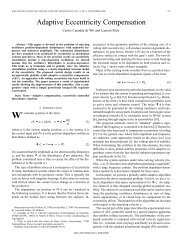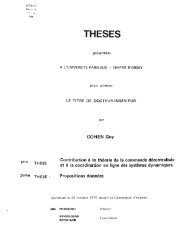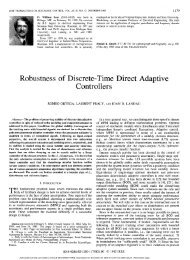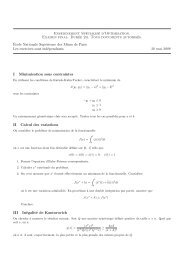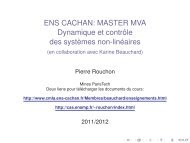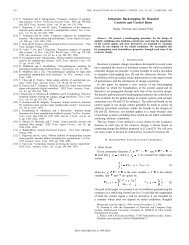Copyright © by SIAM. Unauthorized reproduction of this article is ...
Copyright © by SIAM. Unauthorized reproduction of this article is ...
Copyright © by SIAM. Unauthorized reproduction of this article is ...
Create successful ePaper yourself
Turn your PDF publications into a flip-book with our unique Google optimized e-Paper software.
HOMOGENEOUS OBSERVER DESIGN 1833Such a domination approach has a long h<strong>is</strong>tory. It <strong>is</strong> the cornerstone <strong>of</strong> the resultsin [13] (see also [27] and [24]), where a linear controller was introduced to deal withnonlinear systems. Th<strong>is</strong> approach has also been followed with nonlinear controllers in[22] and more recently in combination with weighted homogeneity in [35, 26, 28] andthe references therein.In the context <strong>of</strong> homogeneity in the bi-limit, we use <strong>th<strong>is</strong></strong> approach exploiting theproposed backstepping and recursive observer designs. Following the idea introduced<strong>by</strong> Qian in [26] (see also [27]), the output feedback we proposed <strong>is</strong> given <strong>by</strong>(5.2)˙ˆX n = L()S n ˆXn + B n φ n (ˆX n )+K 1 (x 1 − ˆX 1) , u = L n φ n (ˆX n ) ,with ˆX n in R n and where φ n and K 1 are continuous functions and L <strong>is</strong> a positivereal number. Employing the recursive procedure given in sections 3 and 4, we get thefollowing theorem, whose pro<strong>of</strong> <strong>is</strong> in section 5.2.1Theorem 5.1. For all real numbers d 0 and d ∞ in (−1,n−1), there ex<strong>is</strong>ts ahomogeneous in the bi-limit function φ n : R n → R with associated triples (r 0 , 1+d 0 ,φ n,0 ) and (r ∞ , 1+d ∞ ,φ n,∞ ) and a homogeneous in the bi-limit vector field K 1 :R n → R n with associated triples (r 0 , d 0 ,K 1,0 ) and (r ∞ , d ∞ ,K 1,∞ ) such that for allreal numbers L>0 the origin <strong>is</strong> a globally asymptotically stable equilibrium <strong>of</strong> thesystems (5.1) and (5.2) and their homogeneous approximations.We can then apply Corollary 2.22 to get an output feedback result for nonlinearsystems described <strong>by</strong>(5.3) ẋ = S n x + B n u + δ(t), y = x 1 ,where δ : R + → R n <strong>is</strong> a continuous function related to the solutions as described inthe two corollaries below and proved in section 5.2. Depending on whether d 0 ≤ d ∞or d ∞ ≤ d 0 , we get an output feedback result for systems in feedback or feedforwardform.Corollary 5.2 (feedback form). If, in the design <strong>of</strong> φ n and K 1 , we selectd 0 ≤ d ∞ , then for all positive real numbers c 0 and c ∞ there ex<strong>is</strong>ts a real numberL ∗ > 0 such that for every L in [L ∗ , +∞), the following holds:• For every class K function γ z and class KL function β δ , we can find two classKL functions β x and βˆx such that, for each function t ∈ [0,T) ↦→ (x(t), ˆX n (t),δ(t),z(t)),T ≤ +∞, with (x, ˆX n ) C 1 and δ and z continuous, which sat<strong>is</strong>fies (5.3), (5.2), andfor i in {1,...,n} and 0 ≤ s ≤ t




